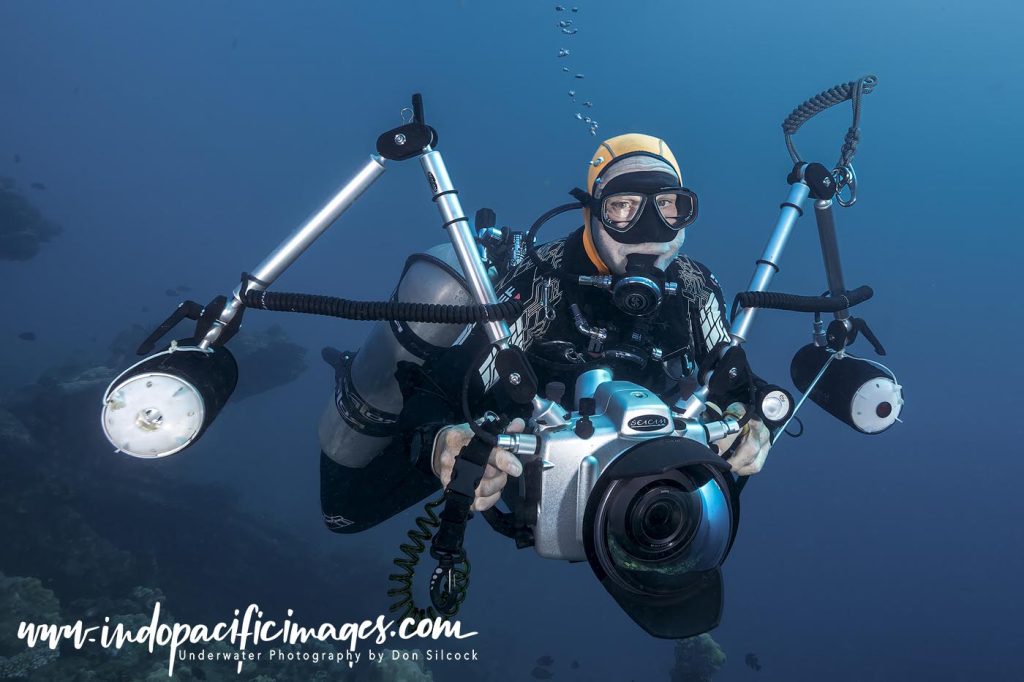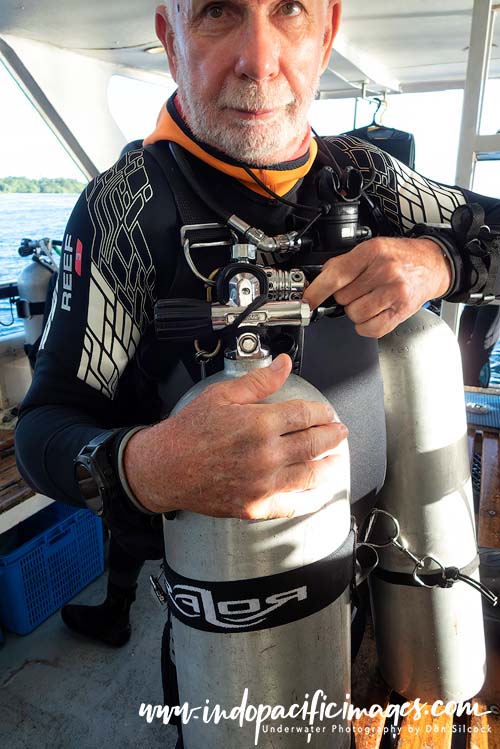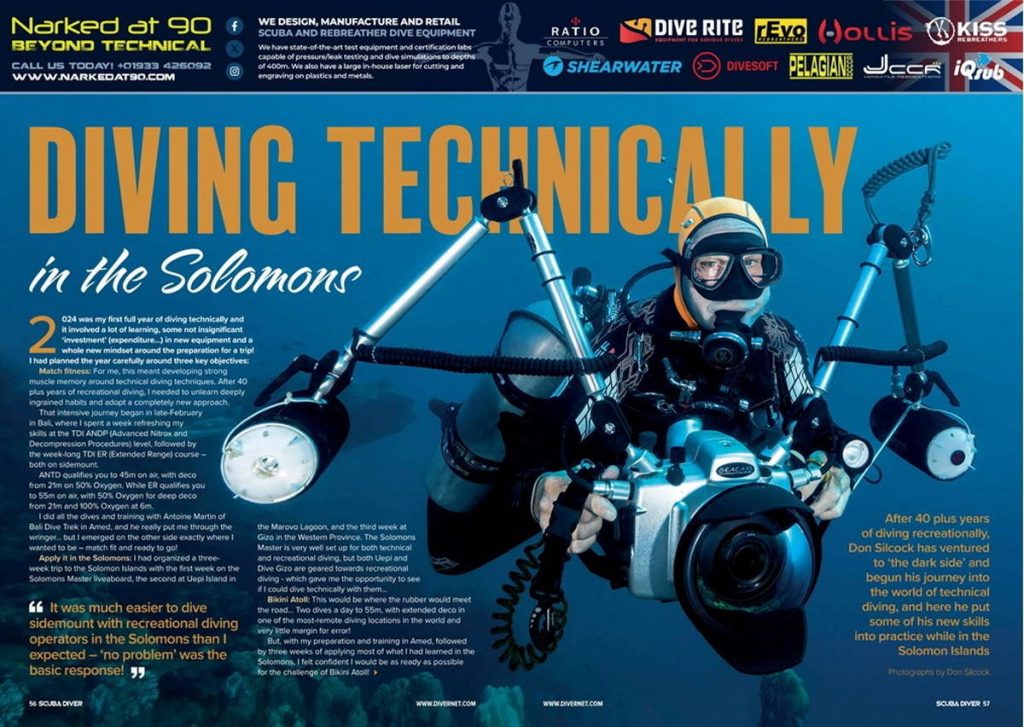2024 was my first full year of diving technically and it involved a lot of learning. Some not insignificant “investment” (expenditure…) in new equipment and a whole new mindset around the preparation for a trip!
I had planned the year carefully around three key objectives:
Match Fitness
For me, this meant developing strong muscle memory around technical diving techniques – not easy after 40+ years of recreational diving…
I needed to unlearn deeply ingrained habits and adopt a completely new approach. And that intensive journey began in late February in Bali.
Where I spent a week refreshing my skills at the TDI ANDP (Advanced Nitrox and Deco Procedures) level. Followed by the week-long TDI ER (Extended Range) course – both on sidemount.


ANDP qualifies you to 45m on air, with deco from 21m on 50% Oxygen. While ER qualifies you to 55m on air, with 50% Oxygen for deep deco from 21m and 100% Oxygen at 6m.
I did all the dives and training with Antoine Martin of Bali Dive Trek in Amed, who really put me through the ringer… But I emerged on the other side exactly where I wanted to be – match fit and ready to go!
Apply it in the Solomons
I had organized a three-week trip to the Solomon Islands. With the first week on the Solomons Master liveaboard. The second at Uepi Island in the Marovo Lagoon and the third week at Gizo in the Western Province.
The Solomons Master is very well set up for both technical and recreational diving. But both Uepi and Dive Gizo are geared towards recreational diving.
Which gave me the opportunity to see if I could dive technically with them…
Bikini Atoll
This would be where the rubber really would meet the road… Two dives a day to 55m, with extended deco in one of the most remote diving locations in the world and very little margin for error!
But, with my preparation and training in Amed, followed by three weeks of applying most of what I had learned in the Solomons, I felt confident I would be as ready as possible for the challenge of Bikini Atoll!
Diving Technically – WWII Wrecks
Several times a year the Solomons Master switches into “wreck mode”. And explores the many WWII wrecks in and around the famed Iron Bottom Sound to the north of Honiara on the main island of Guadalcanal.
Those wrecks fall into two categories… The ones at recreational depths and the ones in much deeper waters…
The Solomons Master covers both, but the latter deep wrecks are part of dedicated technical diving trips.
Which are typically organized by operations like Dirty Dozen Expeditions who charter the whole boat.


I went for one of the recreation depth wreck weeks. As I simply was not ready for the full-on deep version at that point in time.
As it turned out I was the only person on the wreck week trip that was diving “technically”.
Although it was really “tech-lite…” as I followed the same guidelines as the recreational divers of 60 minutes maximum dives and no decompression.
I did however dive sidemount and used the dives to improve my horizontal trim and refine my regulator switching technique.
Diving Sidemount at Uepi and Gizo
I was expecting some pushback when I got to Uepi Island and asked if it was OK to dive sidemount with twin cylinders instead of a single back mounted tank.
But the response was a quick “sure you can…”
That said, I quickly learned that almost everybody is so used to recreational diving that you soon become the center of attention. And the butt of a few jokes when setting up to dive.
It was very similar at Dive Gizo. No issues with the extra cylinder, but lots of attention, questions and remarkably similar jokes to the ones at Uepi!
Diving Technically – Lessons Learned
Sidemount
It was much easier to dive sidemount with recreational diving operators in the Solomons than I expected. “No problem” was the basic response! But you need to have everything with you, know how to put it all together. And understand how to make sure it is all fully functional as, generally speaking… the operators have very little understanding of tech diving technique and procedures.
The hardest part was gearing up in the dive boat. But I usually managed that by letting everybody else go first, while removal and handing up the sidemount cylinders at the end of the dive proved to be very easy.
Trip Preparation
There is a lot more equipment involved in diving technically. And, even at the basic sidemount level there is probably twice as much “stuff” to be prepared, packed and transported.
Double regulators, special BCD, tank bands and dual computers to name but a few… And, if you forget something the chances that a recreational diving operator will have a replacement available are almost zero!
Air Consumption
Obviously getting into the water with two full tanks of air, or 32% nitrox, gives you twice as much available gas than if you were diving a single back mounted tank.
I use Shearwater computers (Perdix AI and Teric) plus their Swift transmitters. Which allows me to set up alarms to remind me to switch regulators and monitor my consumption rates. I also do that when using a single tank. But what I found was that simply having an excess of gas available reduced my consumption significantly.
Clearly that’s a mental thing… But I found it really interesting that just by knowing you have plenty of gas, you relax and lower your consumption in the process!
Big Positive – Underwater Photography…
Perhaps the most significant benefit I got from diving technically in the Solomons was the impact it had on my underwater photography. I have long believed that the first step in becoming a better underwater photographer is mastering neutral buoyancy as it allows you to become the stable platform from which to take your images.
There are many aspects to technical diving, but fundamental to everything you learn is your neutral buoyancy, horizontal trim and the finning techniques that allow you to maneuver in tight spaces and overhead environments. Those same skills applied to underwater photography make a huge difference to your ability to position yourself and get better images!
Diving Technically – Scuba Diver Article
Scuba Diver magazine recently published a four-page version of this Diving Technically article and you can use this link to download it.

